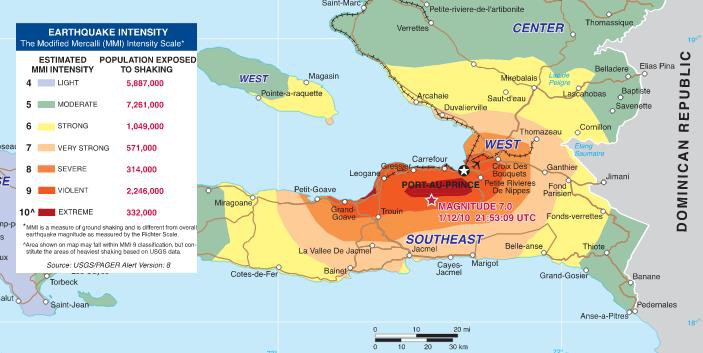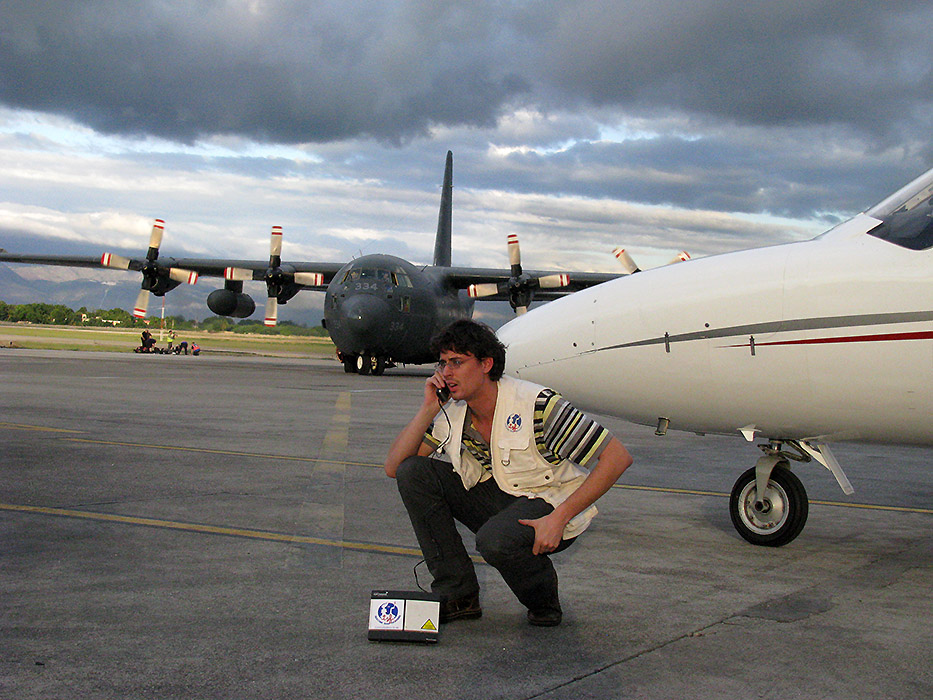Haiti Earthquake
Context: Earthquake
Start date: 13/01/2010
End date: 28/02/2010
Areas of intervention: 9 cities and towns in 2 departments
- Port-au-Prince, Ouest department
- Léogâne, Ouest department
- Carrefour, Ouest department
- Lacul, Ouest department
- Gressier, Ouest department
- Petit Goave, Ouest department
- Grand Goave, Ouest department
- Jacmel, Sud-Est department
- Bainet, Sud-Est department
Activities:
- Telecoms assessments
- Support to coordination
- Humanitarian calling operations
7 telecoms centres
+100 agencies & NGOs supported
1 300 relief workers supported
218 GB of data transferred by relief workers
755 hours of voice communication offered
10 600 calls offered to affected population
+60 000 individuals reconnected
100% of international calls
Context
On 12th January 2010, a powerful earthquake measuring 7 on the Richter scale struck western Haiti, 17 km southwest of the capital Port-au-Prince. Three million people were affected in the departments of Ouest, Sud-Est and Nippes. The most affected areas were the capital Port-au-Prince, as well as the towns of Carrefour, Gressier, Leogane, Petit Goave, Grand Goave and Jacmel.
On 13th February, the Haitian government reported a toll of 222,500 deaths, 300,000 injured and 1.2 million homeless. 467,701 people fled the capital and sought refuge in their families outside the affected areas (Artibonite, Center, Grande Anse). The situation was alarming along the border with the Dominican Republic where a considerable number of displaced people (170,000) increased the vulnerability of local communities. In terms of casualties, this earthquake marked the worst disaster for humanitarian organisations in recent decades.

The earthquake deeply weakened the government's relief capacities by destroying government buildings, including the collapse of the Presidential Palace, which narrowly spared President Preval and Prime Minister Bellerive.
Similarly, United Nations agencies, and in particular the Stabilisation Mission in Haiti (MINUSTAH), were hardly hit by the collapse of their headquarters in Port-au-Prince and the death of their chief and deputy.
In addition, the vital infrastructures were damaged or destroyed - hospitals, schools, means of transport (air, sea, land), telecommunications and supply chains all destroyed or inoperative. During the first two weeks of the emergency phase, the lack of transport and petrol, the blockage of major roads, particularly around the airport, as well as instability in terms of security, were major challenges for the delivery of aid.
Deployment
Alerted an hour after the earthquake, a first team from Télécoms Sans Frontières was deployed from the Americas base and was operational on the ground the day after the disaster. A second team from the international headquarters in France arrived on 15th January.
For more than six weeks, supported by the European Civil Protection and Humanitarian Aid Operations body (ECHO), TSF intervened directly among affected populations by conducting humanitarian calling operations and served the humanitarian community by installing high-speed telecommunications centres in strategic coordination hubs.
Telecoms assessments
A first telecom assessment was carried out in the airport buildings the day after the earthquake. The landlines and GSM were destroyed. Upon arrival in the field, TSF provided IT and technical support as well as satellite connections for the airport-based humanitarian community.
Further assessments of the telecom situation in and around Port-au-Prince, made possible by easier access to these affected areas, revealed considerable damage to the telecommunications and electricity infrastructure:
- Collapse of many towers and GSM antennas at the top of buildings;
- Disturbed terrestrial telecommunications networks;
- Services of mobile providers were seriously affected or overloaded.
Haiti's only fibre optic data connectivity was based on intercontinental routes (cables); these having been interrupted, the local providers were no longer operational.
Support to humanitarian and national coordination
Upon arrival, TSF teams assisted humanitarian workers by installing high-speed connections in strategic coordination centres to the benefit of the entire community: UN agencies, the European Commission, local and international NGOs and local authorities. Specific telephone and Internet connections were made available to the President and the Prime Minister.
TSF teams provided IT and telecom resources and assisted organisations as follows:
- The UNDAC operations centre at the Search and Rescue (SAR) camp at Port-au-Prince Airport was connected on 14th January until it closed on 23th January;
- The MINUSTAH logistics base (LogBase), the main humanitarian hub in Port-au-Prince, connected on 14th January - The UN Emergency Telecommunications Cluster (ETC) took over on 8th February - TSF equipment remained in place until 24th February for emergency use;
- The French inter-agency camp in Port-au-Prince connected on 2d February until closure on 1st April;
- The On-Site Operations Coordination Centre (OSOCC) in Jacmel, a secondary hub connected from 28th January to 11th February;
- The OSOCC in Léogâne, secondary hub connected on 8th February until 17th February.
TSF also supported the Haitian authorities:
- On 15th January, TSF installed a data connection (BGAN) in the building housing the President, the Prime Minister, and the Ministries (building of the DCPJ);
- On 25th January, TSF installed connections at the headquarters of the Haitian National Police. TSF handed the connection over to a local ISP on 23rd February.
The following services were provided:
- Internet access (BGAN, VSAT, ISP);
- Secure Wi-Fi network;
- HTTP proxy server (authentication, cache and monitoring);
- Satellite telephones (BGAN and MiniM);
- Laptop;
- Printers, scanners, fax;
- Mobile phones were also distributed to UNDAC members.
Since the beginning of the disaster, the activity of coordination and the rescue centres had been incessant and all relief actors were heavily mobilised. TSF tailored its support to the demands and needs of the humanitarian community.
Throughout the mission, TSF teams provided ongoing technical support to humanitarian workers via dedicated helpdesks and by performing activities ranging from basic operations (such as configuring wireless or printer connections, solving problems on computer hardware or software) to further operations (installation of BGANs and VSATs, such as for example the UNICEF VSAT, wireless connections and complete installation of field offices).
At least three IT technicians were permanently based in the LogBase camp to provide ongoing technical support.
Humanitarian calling operations
The affected population gathered in public spaces (squares, parks, football fields, gardens). In the camps, there was no water, no food and the sanitary conditions were deplorable.
Four to five TSF teams regularly visited the affected areas of Port-au-Prince, Jacmel, Carrefour, Leogane, Lacul, Bainet, Gressier, Petit Goave and Grand Goave to set up calling centres. TSF focused on the most important camps (at least 300 families). It took two or three days to cover all the needs in the main camps, such as Champ de Mars in Port-au-Prince or Adventists in Carrefour.
More than 600 camps were identified across the territory. Site selection was partly provided by local volunteers using satellite imagery (Google Earth, UNOSAT), along with information exchange with other organisations involved in camp management. The day before the installation of a calling site, the needs were assessed directly by TSF.
Once the centre was set up, TSF offered the affected civilians calls via satellite phones to the destination of their choice. The telephone centres were generally open from 10 am to 5 pm. Local volunteers travelled around the neighbourhood with a megaphone to inform people about the service offered by TSF. FM radio (RFI, Radio FM, Radio Tropic) were regularly used to broadcast the location of humanitarian calling operations of the following day.
"Thanks to TSF, I was able to reach my uncle in Venezuela. It was essential to give him news of the family, to tell him that we were alive. For me, the most important thing to continue living is to keep in touch with the family, whatever the situation."
Mr Bertry, Boyer Square camp, Port-au-Prince.
"My mother, my child and I are alive and we need help, we need money to buy food and water to survive. Thanks to TSF's calling operations, I was able to reach my sister in Orlando in the US, to tell her about the situation and ask her for money. This call was essential."
Shirley Lafleur, 24, Delmas camp 42.
In mid-February, with the reestablishment of local telecommunications, 80% of the affected civilians had contacted their relatives. On 22th February, TSF ended its calling operations.







































